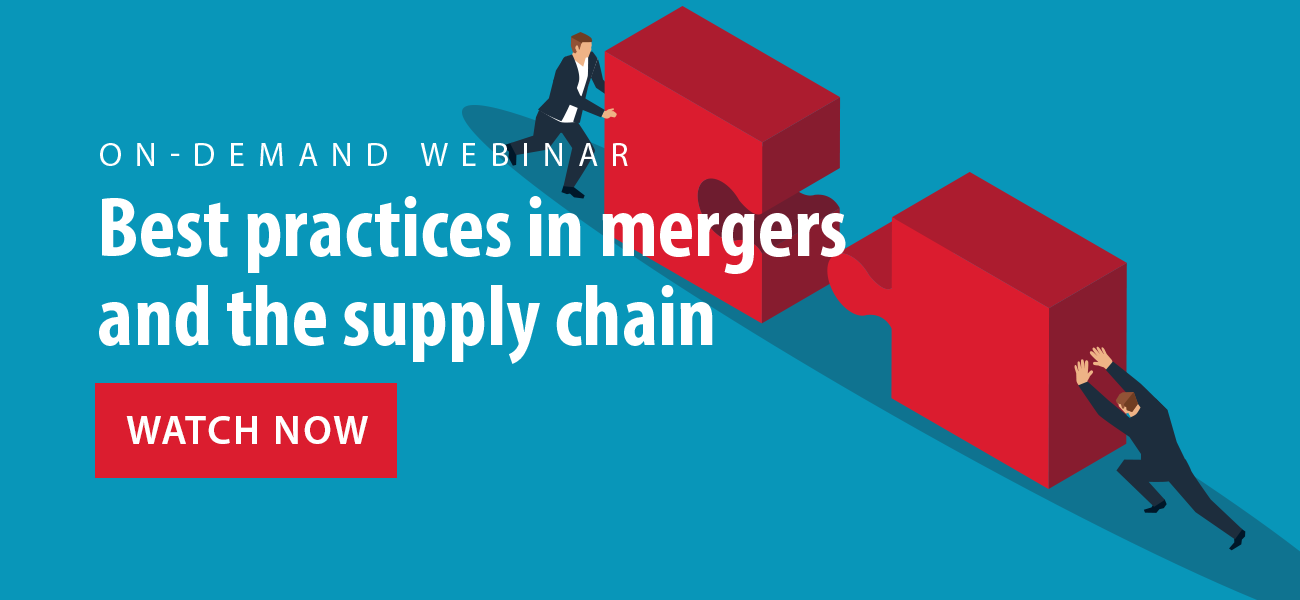
Mergers and acquisitions are often viewed as good business strategy, and yet according to the Harvard Business Review between 70 percent and 90 percent of acquisitions fail. While there are many reasons for these failures, the complexity of post-merger integration is often a contributing factor.
In today’s volatile global economic environment, facing severe disruption from trade conflicts and the effects of the ongoing global pandemic, managing supply chain integration is more important than ever. Developing a blueprint for integrating supply chain management processes and systems is critical for preparing for post-merger integration.
In a recent webinar, sponsored by Kinaxis, Robert Kugel, SVP and Research Director at Ventana Research, discussed the key role that supply chain technology plays in driving post-merger success. Joining Robert was Gerry Hanrahan, Senior Director of Supply Chain Process & Technology for Extreme Networks. Gerry has had significant experience in managing M&A integration strategy for global supply chains and during the webinar he shared the insights he’s gained from leading several post-merger integration projects.
The right supply chain technology is essential
As Robert notes, the right supply chain technology is essential for post-merger success for several reasons, including mediating trade-offs, aligning planning models and standardizing processes.
It also helps to reconcile the often conflicting priorities that occur across organizational silos when companies merge: while manufacturing wants long production runs, sales needs product availability and finance wants to minimize working capital. In the absence of a technology solution, these groups tend to work towards optimizing their own key performance metrics, an approach that usually produces sub-optimal results.
Robert highlights the importance of Sales & Operations Planning (S&OP) in particular in post-merger integration, as it’s designed to break down these silos by synchronizing and optimizing operational, financial and supply chain plans.
Supply chain management and S&OP are there to orchestrate the chaos
Supply chain management is often the source of value in M&A transactions because there’s significant room for improvement in the way most companies handle sales and operations planning. A Ventana research study found that only 26 percent of companies believe they manage S&OP processes well or very well, while another 22 percent said they manage theirs poorly. For these companies, especially, supply chain management and S&OP are there to help orchestrate the “post-merger chaos” and create value. The most common sources of value creation include strategic sourcing, logistics, contracting, bundling and product rationalization.
Bad data is the root of all evil
As Robert notes, the importance of having accurate, timely and consistent data in a post-merger context can’t be overstated. Ventana research shows that in dealing with all kinds of analytics, two-thirds of companies spend the bulk of their time in data preparation and error checking before they can even begin doing anything useful with their data.
Data integrity must be maintained in any supply chain-driven process and spreadsheets are simply not up to the task. That’s why a single global platform for S&OP is so important. Instead of the single point of failure that you get with spreadsheets, an S&OP platform provides a global view of real-time data, supports a unified management approach, and can successfully co-exist with disparate enterprise systems, such as multiple ERPs, CRM, and demand planning. What’s more, a modern supply chain platform enables you to move from a sequential model to a concurrent planning model.
Post-merger integration best practices from Extreme Networks
In his role at Extreme Networks, Gerry Hanrahan has led several post-merger supply chain integrations. Over the course of these projects, he has learned an enormous amount about what works and what doesn’t. In the webinar, Gerry summarized the challenges the company encountered while working through multiple mergers. These included a lack of integration, an inability to scale, a reliance on a cascaded approach built in Excel, and a lack of data sharing across organizational silos.
To address these and other challenges, the company realized it needed to put in place a solid foundation that would help them complete additional integrations in the future. A team was set up to conduct a technology assessment in which they would leverage the experience of a number of their acquisitions. One of these acquisitions, Avaya, had been a 7-year customer of the Kinaxis platform. The assessment team had an opportunity to speak with the users of the system and really understand where they had come from and where they had gone to in terms of their operational metrics and the overall benefits that the platform provided.
In summing up, Gerry offered six lessons learned for companies tackling supply chain integration after a merger or acquisition. Check out the on-demand webinar to get the full details.






